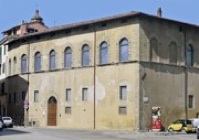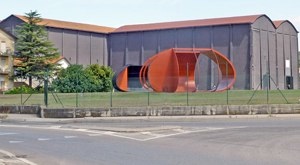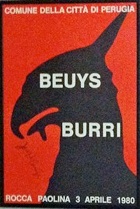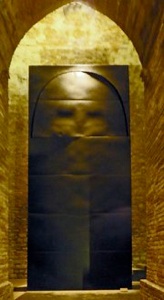

Alberto Burri (1915-95)
Alberto Burri, who was born in Città di Castello, trained in medicine at Perugia. He was a medical officer in the Italian army in the Second World War and was captured by the Americans in Tunisia. He took up painting while he was held in Texas as a prisoner of war. He had his first exhibition in Rome in 1947-8.
Città di Castello
Alberto Burri founded the Fondazione Palazzo Albizzini "Collezione Burri" in 1978, as a tribute to his native city. The foundation exhibits over 250 of his works in the two locations described below’. For more information, see the website of Fondazione Palazzo Albizzini "Collezione Burri"
Palazzo Albizzini

The palace was bought by the Cassa di Risparmio di Città di Castello and restored in in 1979-81. It was then given to the Fondazione Palazzo Albizzini "Burri Collection" for a period of 99 years. The palace was opened as a museum of works by Burri in 1981.
Some 130 works that were executed in 1948-89 are exhibited chronologically in 20 rooms.
Ex Seccatoi del Tabacco

Par of the collection has been exhibited in what were the drying sheds of the tobacco factory since in 1990.
Alberto Burri used these sheds as a laboratory for the production of large works from 1978. The Fondazione Palazzo Albizzini "Burri Collection" took over the complex in 1989.
The sheds contain some 128 works that form part of the following cycles:
-
✴Il Viaggio (1979);
-
✴Orsanmichele (1980);
-
✴Sestante (1982);
-
✴Rosso e Nero (1984);
-
✴Cellotex T (1975-1984);
-
✴Annottarsi (1985-1987);
-
✴Non Ama il Nero (1988);
-
✴Grandi Neri (1988-1990);
-
✴Metamorfotex (1991); and
-
✴Il Nero e l'Oro (1992-1993)
The three large sculptures in black-painted iron outside the sheds are entitled:
-
✴Grande Ferro Sestante (1982);
-
✴Grande Ferro K (1982); and
-
✴Grande Ferro U (1990).
Perugia

Il Grande Nero (1980)


Alberto Burri gave this huge statue (1980) to the city of Perugia in 1984, and it is placed beside the escalator in the excavated area under Palazzo della Provincia (see Walk VII). The upper, semi-circular section rotates very slowly, so that the woman’s face on it is rarely visible.
Return to Museums of Città di Castello.
Return to: Walk I (Ex Seccatoi del Tabacco); or Walk II (Palazzo Albizzini).

